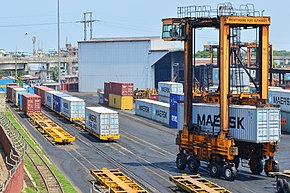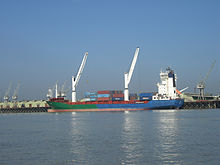Chittagong Harbor
| Chittagong Harbor | |||
|---|---|---|---|
| Data | |||
| UN / LOCODE | BD CGP | ||
| owner | Government of Bangladesh | ||
| operator | Chittagong Port Authority | ||
| opening | 1887 | ||
| Throughput | 23,480 M | ||
| Container (TEU) | 2,808 M. | ||
| website | http://cpa.gov.bd/ | ||
| Geographic information | |||
| place | Chittagong , Chittagong Division | ||
| People's Republic | Bangladesh | ||
| Country | Bangladesh | ||
| New Mooring Terminal, Chittagong Harbor | |||
| Coordinates | 22 ° 18 ′ 47 " N , 91 ° 48 ′ 0" E | ||
|
|||
The port of Chittagong ( Bengali চট্টগ্রাম বন্দর ) is the busiest seaport on the coast of the Gulf of Bengal and the second most important in the entire region of the Gulf of Bengal dependent countries. According to Lloyd’s , it was the 76th busiest port in the world in 2016. Located in the Bangladeshi port city of Chittagong and on the banks of the Karnaphuli , the port of Chittagong handles 90% of the export-import trade of Bangladesh and was used by India , Nepal and Bhutan for transshipment .
The congestion is a major challenge in the port of Chittagong. Between January and July 2017, the port had a traffic jam rate of 84.3 hours.
history
The Chittagong area has been around since the 4th century BC. Known as a seaport. In the 2nd century the port appeared on the map of the Greco-Roman cartographer Claudius Ptolemy . The map mentions the port as one of the most beautiful in the eastern world. The Periplus Maris Erythraei documents the trade between Chittagong and private traders from Roman Egypt .

Arab traders have visited Chittagong since the 9th century. In 1154, Al-Idrisi found that traders from Baghdad and Basra regularly traveled to Chittagong. Arab traders played an important role in spreading Islam in the region. The port appears in the travel reports of the Chinese explorers Xuanzang and Ma Huan . The Moroccan explorer Ibn Battūta and the Venetian traveler Niccolo di Conti visited the port in the 14th century. The historic port had shipping trade with Africa , Europe , China and Southeast Asia .
The Portuguese enclave in Chittagong focused on the port in the 16th and 17th centuries. After the Portuguese were driven out, Chittagong came under the rule of the Mughal Empire and was called Islamabad. It became an important shipbuilding center supplying the Mughal and Ottoman navies. After the rise of British dominance in Bengal after the Battle of Plassey, the Nawab of Bengal handed the port to the British East India Company in 1760 .
Modern
The modern port of Chittagong was established in 1887 under the Port Commissioners Act in the British Indian Empire . The port began its official operation in 1888 under a representative. The busiest trade routes were with British Burma , including the ports of Akyab and Rangoon , and other Bengali ports, including Calcutta , Dhaka and Narayanganj . In the year 1889–90, exports totaling 125,000 tons were handled in the port. The beach road was built next to the harbor. Between 1905 and 1911, Chittagong was the main seaport of East Bengal and Assam. It was made the terminus of the Assam Bengal Railway . The hinterland of the port included the entire colonial Assam (present-day northeast India ). Trade between British India and British Burma increased rapidly in the early 20th century. The Bay of Bengal became one of the busiest shipping centers in the world, competing with traffic from the Atlantic ports . In 1928 the British government declared Chittagong to be the "main port" of British India. Chittagong was important to the petroleum industry that developed in Assam and Burma . It was used for the jute and rice trade. During the Second World War , the port of Chittagong was used by the Allies as part of the Burma campaign .
After the partition of India , the Governor General of Pakistan , Muhammad Ali Jinnah , visited Chittagong and emphasized its importance and future potential. The Chittagong Port Trust was established in East Pakistan in 1960. 100 workers in Chittagong port were killed in 1971 during the Bangladesh war . The Soviet Pacific Fleet was commissioned with mine clearance and salvage in the port after the war. In the years after independence, the port benefited from the growth of heavy industry and logistics in the Chittagong metropolitan area. The union movement was strong in the late 1990s.
A major expansion took place with the construction of the new mooring terminal in the first decade of the 21st century.
administration
The Chittagong Port Authority is responsible for managing the port.
Investments
Moorings
| Type of mooring | Number of moorings | Remarks |
|---|---|---|
| General cargo | 6th | |
| Container | 14th | |
| oil | 3 | For handling crude and product oil ships up to 186 meters in length |
| Grain | 1 | Ships up to 186 meters in height |
| cement | 1 | |
| TSP | 1 | Ship up to 175.25 meters in height |
| Chittagong urea fertilizers | 1 | Ships up to 176 meters and can be loaded up to a maximum draft of 8.5 meters. |
| KAFCO urea | 1 | Ships with a length of 186 meters |
| KAFCO ammonia | 1 | Ships with a Lüa of up to 186 meters can be loaded up to a maximum draft of 9.2 meters |
| Dry dock | 3 | |
| River pier No. 3 | 1 | Ships up to 182.9 Lüa and 7.76 meters draft for cooking oil and POL in large quantities |
| River pier No. 8 | 1 | Ships up to 186 meters and 8 meters draft for vegetable oil carriers |
| River pier No. 9 | 1 | Ships up to 186 meters and 6 meters draft for the repair of the ship / deposit. |
| River pier No. 10 | 1 | Ships up to 145 meters LOA and 7.5 meters draft for repairing the ship / deposit. |
Container terminals
The port has several container terminals , most of which are owned by private companies.
- New Mooring Terminal
- Chittagong Container Terminal
- KDS Logistics Terminal
- Orient Overseas Container Line (OOCL) Terminal
- Summit Alliance Container Terminal
Industrial terminals
- Eastern Refinery Terminal
- Karnaphuli Fertilizer Company (KAFCO) Terminal
- Jamuna Oil Company Terminal
- Padma Oil Company Terminal
- Meghna Petroleum Terminal
- Omera Fuels Limited Terminal
safety

The Bangladeshi Coast Guard is responsible for security in the vicinity of the port.
Naval and Air Force Base
The largest naval base of the Bangladeshi Navy, the BNS Issa Khan, and the Bangladesh Naval Academy are located in the port of Chittagong. The port is the home base of most units in the Bangladeshi Navy, including the submarine fleet. The naval units based in Chittagong often hold joint exercises with the navies of other countries and also visit foreign naval ships. A rocket launch pad is located near the port. The Bangladesh Air Force maintains its BAF Zahurul Haq Air Base near the port. In addition, the Bangladeshi Navy operates an airborne surveillance squadron.
crime
The year 2000 saw the greatest number of raids in Chittagong's documented history. Many of the raids resulted in the theft of mooring lines , sacrificial anodes, and other moving parts of marine equipment. In 2005 it had the highest number of raids in any port area in the world. Because of this, the Government of Bangladesh has increased the presence of the Navy and Coast Guard in the region.
Web links
- Chittagong Port in Banglapedia
- Chittagong Port Authority website
Individual evidence
- ↑ a b কন্টেইনার হ্যান্ডলিং-চবক. In: Chittagong Port Authority. Retrieved May 25, 2019 (Bengali).
- ↑ Chittagong Port ranks 76th in Lloyd's Register. In: Lloyd's of London . October 8, 2016, accessed May 25, 2019 .
- ↑ Ziaul Haque Munim, Hercules Haralambides: Competition and co-operation for intermodal container transhipment: A network optimization approach . In: Research in Transportation Business & Management (= Port co-operation: types, drivers and impediments ). tape 26 , March 1, 2018, ISSN 2210-5395 , p. 87–99 , doi : 10.1016 / j.rtbm.2018.03.004 ( online [accessed on May 25, 2019]).
- ↑ Syful Islam: Congestion paralyzes Chittagong port. In: JOC.com. July 19, 2017, accessed May 25, 2019 .
- ^ A b Trudy Ring, Noelle Watson, Paul Schellinger: Asia and Oceania: International Dictionary of Historic Places . Routledge, 2012, ISBN 978-1-136-63979-1 ( com.bd [accessed May 25, 2019]).
- ↑ Chittagong City. In: Banglapedia. Retrieved May 25, 2019 .
- ^ Charles Stewart: The History of Bengal: From the First Mohammedan Invasion Until the Virtual Conquest of that Country by the English, AD 1757 . Black, Parry, and Company, 1813 ( com.bd [accessed May 25, 2019]).
- ↑ Chittagong | Bangladesh. In: Britannica.com. Retrieved May 25, 2019 .
- ^ J. Forbes Munro: Maritime Enterprise and Empire: Sir William Mackinnon and His Business Network, 1823-93 . Boydell Press, 2003, ISBN 978-0-85115-935-5 ( google.ch [accessed May 25, 2019]).
- ↑ Willis's Current Notes: Willis's Current Notes . 1886 ( google.ch [accessed on May 25, 2019]).
- ^ The Daily Star Web Edition Vol. 5 Num 389. In: The Daily Star . Retrieved May 25, 2019 .
- ↑ King's College London: The Bay of Bengal: Rise and Decline of a South Asian region. In: YouTube . February 8, 2016, accessed May 25, 2019 .
- ↑ a b Chittagong Port Authority. In: Banglapedia. Retrieved May 25, 2019 .
- ↑ ZH Zaidi, Quaid-i-Azam Papers Project: Quaid-i-Azam Mohammad Ali Jinnah Papers: Pakistan: pangs of birth, August 15-September 30, 1947 . Quaid-i-Azam Papers Project, National Archives of Pakistan, 2001, ISBN 978-969-8156-09-1 ( google.ch [accessed May 25, 2019]).
- ^ Soviet Naval Presence in the Indian Ocean. In: Central Intelligence Agency . May 7, 1975, accessed May 25, 2019 .
- ^ New Mooring container terminal opens. In: Hellenic Shipping News Worldwide. October 19, 2015, accessed May 25, 2019 .
- ↑ Chittagong Port Overview and Other Inland Transportation. Retrieved May 25, 2019 .
- ↑ KDS launches Tk 300cr ICD in Chittagong. In: The Daily Star . March 22, 2009, accessed May 25, 2019 .
- ↑ Terminals & Facilities. In: OOCL. Retrieved May 25, 2019 .
- ↑ FMO and IDCOL combine for port infrastructure loan in Bangladesh R. In: TXFNews. July 7, 2015, accessed May 25, 2019 .
- ^ New oil storage terminal in BD | banglanews24.com. In: Banglanews24. September 2, 2013, accessed May 25, 2019 .
- ↑ Sumit Sen: Bangladesh building missile arsenal. In: Times of India . September 12, 2008, accessed May 25, 2019 .
- ↑ Bruce A. Ellerman, Andrew Forbes, David Rosenberg: Piracy and Maritime Crime: Historical and Modern Case Studies . Lulu.com, 2010, ISBN 978-1-105-04225-6 ( google.ch [accessed on May 25, 2019]).
- ^ Hill, Peter: A modern plague of pirates: modern piracy in the 21st Century; protect your ship and your crew; a practical guide for avoiding contemporary piracy on the high seas . Offshore and Marine Publ, East Mersea 2009, ISBN 978-0-9562107-0-8 ( Google Books [accessed May 25, 2019]).







